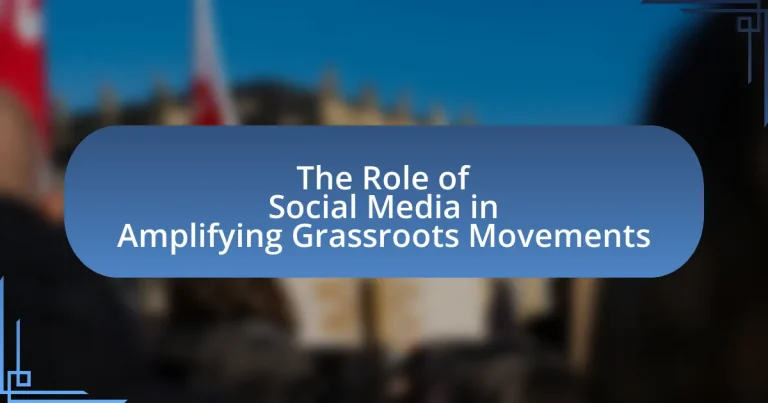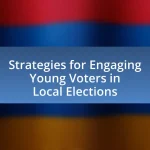The article examines the significant role of social media in amplifying grassroots movements, highlighting its capacity for rapid communication, mobilization, and community engagement. It discusses how platforms like Facebook, Twitter, and Instagram facilitate grassroots initiatives by enabling activists to organize events, share information, and rally support effectively. The article also addresses the challenges faced by these movements, including algorithmic bias, misinformation, and censorship, while emphasizing the importance of storytelling and metrics for measuring impact. Additionally, it outlines best practices for grassroots organizations to enhance their social media strategies and build donor trust.

What is the Role of Social Media in Amplifying Grassroots Movements?
Social media plays a crucial role in amplifying grassroots movements by providing a platform for rapid communication, mobilization, and community building. It enables activists to share information, organize events, and rally support on a global scale, often leading to increased visibility and engagement. For instance, the Black Lives Matter movement gained significant traction through social media platforms, where hashtags like #BlackLivesMatter facilitated widespread awareness and participation in protests. Research by the Pew Research Center indicates that 69% of adults in the U.S. use social media, highlighting its potential reach and influence in shaping public discourse and driving social change.
How does social media facilitate grassroots movements?
Social media facilitates grassroots movements by providing a platform for rapid communication and mobilization among individuals with shared interests. This immediacy allows activists to organize events, share information, and rally support quickly, often leading to significant participation in protests or campaigns. For example, the Arab Spring demonstrated how platforms like Twitter and Facebook enabled citizens to coordinate protests and disseminate information about government actions, resulting in widespread political change across multiple countries. Additionally, studies show that social media can increase engagement and awareness, as seen in movements like Black Lives Matter, where hashtags and viral content have drawn global attention to social justice issues.
What platforms are most effective for grassroots mobilization?
Social media platforms such as Facebook, Twitter, and Instagram are most effective for grassroots mobilization. These platforms enable rapid information dissemination, community engagement, and mobilization of supporters. For instance, Facebook’s group features allow users to create communities around specific causes, facilitating organization and event planning. Twitter’s real-time communication capabilities enable quick updates and mobilization during events, as seen in movements like Black Lives Matter. Instagram’s visual storytelling fosters emotional connections, enhancing engagement and support for grassroots initiatives. Studies show that social media significantly increases participation rates in grassroots campaigns, with a Pew Research Center report indicating that 69% of adults in the U.S. use Facebook, making it a powerful tool for outreach and mobilization.
How do social media algorithms impact visibility for grassroots initiatives?
Social media algorithms significantly impact the visibility of grassroots initiatives by determining which content is prioritized in users’ feeds. These algorithms often favor posts with higher engagement rates, such as likes, shares, and comments, which can lead to increased exposure for grassroots movements that successfully generate interaction. For instance, a study by the Pew Research Center found that 69% of adults in the U.S. use social media, and content that resonates with users can quickly go viral, amplifying the reach of grassroots campaigns. Additionally, algorithms may also limit visibility for content that does not align with platform policies or that lacks engagement, making it crucial for grassroots initiatives to create compelling and shareable content to enhance their visibility.
Why is social media crucial for grassroots movements?
Social media is crucial for grassroots movements because it enables rapid communication and mobilization among supporters. This platform allows grassroots organizations to disseminate information quickly, engage with a wider audience, and coordinate actions effectively. For instance, during the Arab Spring, social media played a pivotal role in organizing protests and sharing real-time updates, which significantly contributed to the movements’ momentum and visibility. Additionally, studies show that social media can increase participation rates by up to 50%, demonstrating its effectiveness in rallying support and fostering community engagement.
What advantages does social media provide over traditional media?
Social media offers real-time communication and engagement, which traditional media cannot match. This immediacy allows grassroots movements to mobilize support quickly, disseminate information widely, and respond to events as they unfold. For instance, during the Arab Spring, social media platforms like Twitter and Facebook enabled activists to organize protests and share updates instantly, reaching millions globally within minutes. In contrast, traditional media relies on scheduled broadcasts and print cycles, which can delay the spread of critical information. Additionally, social media provides a platform for diverse voices and grassroots narratives that are often overlooked by mainstream media, fostering inclusivity and community-driven dialogue.
How does social media enhance community engagement and participation?
Social media enhances community engagement and participation by providing platforms for real-time communication and interaction among community members. These platforms facilitate the sharing of information, mobilization of resources, and organization of events, which are essential for grassroots movements. For instance, a study by the Pew Research Center found that 69% of adults in the U.S. use social media, enabling widespread access to community initiatives and discussions. Additionally, social media allows for diverse voices to be heard, fostering inclusivity and encouraging participation from various demographic groups. This increased connectivity and accessibility ultimately strengthens community ties and drives collective action.
What challenges do grassroots movements face on social media?
Grassroots movements face significant challenges on social media, including algorithmic bias, misinformation, and platform censorship. Algorithmic bias can limit the visibility of grassroots content, as social media platforms often prioritize mainstream narratives over smaller movements, making it difficult for these groups to reach a wider audience. Misinformation can undermine the credibility of grassroots campaigns, as false narratives can spread rapidly, overshadowing their messages. Additionally, platform censorship can lead to the removal of posts or accounts associated with grassroots movements, stifling their ability to organize and communicate effectively. These challenges are evidenced by studies showing that smaller movements often struggle to gain traction compared to larger, established organizations, highlighting the disparities in social media engagement.
How do misinformation and disinformation affect grassroots campaigns?
Misinformation and disinformation significantly undermine grassroots campaigns by eroding trust and distorting public perception. When false information circulates, it can mislead potential supporters, causing confusion about the campaign’s goals and values. For instance, a study by the Pew Research Center found that 64% of Americans believe that misinformation has a major impact on their understanding of political issues, which directly affects grassroots mobilization efforts. Additionally, disinformation can create divisions within communities, leading to fragmentation and decreased engagement, as individuals may become skeptical of the campaign’s messaging. This dynamic illustrates how the spread of false narratives can weaken the foundational support necessary for grassroots movements to thrive.
What are the risks of censorship and platform policies for grassroots movements?
Censorship and platform policies pose significant risks to grassroots movements by limiting their ability to communicate, organize, and mobilize effectively. These restrictions can lead to the suppression of critical messages, as seen in instances where social media platforms have removed content related to protests or social justice campaigns, thereby stifling public discourse. For example, during the Black Lives Matter protests in 2020, various platforms faced criticism for censoring posts that highlighted police brutality, which hindered the movement’s visibility and outreach. Additionally, algorithmic biases can further marginalize grassroots voices, as platforms may prioritize mainstream narratives over grassroots initiatives, reducing their impact and reach.
How do grassroots movements leverage social media for fundraising?
Grassroots movements leverage social media for fundraising by utilizing platforms to reach a broad audience, engage supporters, and facilitate direct donations. These movements create compelling content that resonates with their target demographic, often sharing personal stories or urgent calls to action that encourage emotional investment. For instance, the Ice Bucket Challenge in 2014 raised over $115 million for ALS research through viral social media engagement, demonstrating the effectiveness of this approach. Additionally, social media allows for real-time updates and transparency, fostering trust and encouraging repeat contributions from supporters.
What strategies are effective for online fundraising through social media?
Effective strategies for online fundraising through social media include leveraging storytelling, utilizing targeted ads, and engaging with followers. Storytelling captures emotional connections, as campaigns that share personal narratives can increase donations by up to 300%, according to a study by the Stanford Social Innovation Review. Targeted ads allow organizations to reach specific demographics, enhancing the likelihood of contributions; Facebook reports that ads can increase fundraising by 30% when aimed at relevant audiences. Engaging with followers through regular updates and interactive content fosters community and encourages sharing, which can amplify reach and drive donations.
How can grassroots movements build donor trust via social media?
Grassroots movements can build donor trust via social media by demonstrating transparency and accountability in their operations. By regularly sharing updates on fundraising efforts, project outcomes, and financial reports, these movements can foster a sense of reliability among potential donors. For instance, a study by the Nonprofit Research Collaborative found that 70% of donors are more likely to contribute to organizations that provide clear information about how their funds are used. Additionally, engaging with donors through interactive content, such as live Q&A sessions or behind-the-scenes videos, can enhance personal connections and trust. This approach not only showcases the movement’s commitment to its mission but also allows donors to feel involved and valued, further solidifying their trust.
What role does storytelling play in grassroots movements on social media?
Storytelling plays a crucial role in grassroots movements on social media by fostering emotional connections and mobilizing support. Through compelling narratives, activists can convey their experiences and the urgency of their causes, making complex issues more relatable and understandable. For instance, the #MeToo movement utilized personal stories to highlight the prevalence of sexual harassment, leading to widespread awareness and action. Research indicates that emotionally charged stories are more likely to be shared, amplifying the reach of grassroots campaigns and increasing engagement. This demonstrates that storytelling not only informs but also inspires collective action, essential for the success of grassroots movements.
How can narratives be crafted to resonate with a wider audience?
Narratives can be crafted to resonate with a wider audience by focusing on universal themes and relatable experiences. This approach ensures that the story connects emotionally with diverse groups, making it more impactful. For instance, using storytelling techniques that highlight shared values, such as justice, community, and resilience, can engage a broader demographic. Research indicates that narratives that incorporate personal stories and testimonials are more effective in fostering empathy and understanding, as seen in studies by the Stanford Social Innovation Review, which emphasize the power of storytelling in social movements. By integrating these elements, narratives become more accessible and compelling, thereby amplifying their reach and influence.
What are the best practices for sharing personal stories on social media?
The best practices for sharing personal stories on social media include authenticity, clarity, and engagement. Authenticity ensures that the story resonates with the audience, as studies show that genuine content fosters trust and connection. Clarity involves presenting the story in a concise and coherent manner, which is crucial since social media users often skim content; research indicates that posts with clear narratives receive higher engagement rates. Engagement can be enhanced by inviting interaction, such as asking questions or encouraging comments, which research from the Pew Research Center highlights as a key factor in building community and support around grassroots movements.
How can grassroots movements measure their impact on social media?
Grassroots movements can measure their impact on social media through metrics such as engagement rates, follower growth, and reach. Engagement rates, which include likes, shares, and comments, indicate how well content resonates with the audience. For example, a study by the Pew Research Center found that social media engagement can significantly amplify messages, leading to increased visibility and support for grassroots causes. Additionally, tracking follower growth over time provides insights into the movement’s expanding influence and reach, which can be quantified using analytics tools like Facebook Insights or Twitter Analytics. These metrics collectively help grassroots movements assess their effectiveness and adapt strategies accordingly.
What metrics are essential for evaluating social media effectiveness?
Key metrics for evaluating social media effectiveness include engagement rate, reach, impressions, conversion rate, and follower growth. Engagement rate measures interactions (likes, shares, comments) relative to total followers, indicating content resonance. Reach quantifies the number of unique users who see content, while impressions count total views, reflecting visibility. Conversion rate tracks actions taken (e.g., sign-ups, purchases) from social media traffic, demonstrating effectiveness in driving desired outcomes. Follower growth indicates audience expansion over time, essential for assessing long-term impact. These metrics collectively provide a comprehensive view of social media performance and its role in amplifying grassroots movements.
How can feedback from social media inform future grassroots strategies?
Feedback from social media can inform future grassroots strategies by providing real-time insights into public sentiment and engagement levels. This feedback allows grassroots organizations to adapt their messaging and tactics based on what resonates with their audience. For instance, a study by the Pew Research Center found that 69% of adults in the U.S. use social media, making it a vital platform for gauging community reactions and preferences. By analyzing comments, shares, and likes, organizations can identify key issues and adjust their strategies to better align with the interests and concerns of their supporters. This data-driven approach enhances the effectiveness of grassroots movements by ensuring that they remain relevant and responsive to their constituents.
What are the best practices for grassroots movements using social media?
The best practices for grassroots movements using social media include creating a clear and compelling message, engaging with the audience consistently, and utilizing various platforms strategically. A clear message helps to unify supporters and attract new followers, while consistent engagement fosters community and encourages participation. Utilizing multiple platforms, such as Facebook, Twitter, and Instagram, allows movements to reach diverse demographics and maximize visibility. Research indicates that movements with strong social media strategies can increase their reach by up to 50%, demonstrating the effectiveness of these practices in mobilizing support and driving action.
How can grassroots organizations create a cohesive social media strategy?
Grassroots organizations can create a cohesive social media strategy by establishing clear goals, identifying target audiences, and maintaining consistent messaging across platforms. Clear goals help organizations focus their efforts, such as increasing awareness or mobilizing supporters. Identifying target audiences allows for tailored content that resonates with specific groups, enhancing engagement. Consistent messaging ensures that all communications reflect the organization’s values and mission, fostering trust and recognition among followers. Research indicates that organizations with a unified social media presence can increase their reach and impact, as seen in the success of movements like Black Lives Matter, which effectively utilized social media to coordinate actions and spread their message.
What tools can assist grassroots movements in managing their social media presence?
Grassroots movements can utilize tools such as Hootsuite, Buffer, and Sprout Social to effectively manage their social media presence. Hootsuite allows users to schedule posts across multiple platforms, track engagement metrics, and monitor conversations, which is essential for maintaining an active online presence. Buffer offers similar scheduling capabilities and provides analytics to assess post performance, enabling movements to refine their strategies. Sprout Social enhances these functionalities with advanced reporting features and social listening tools, allowing grassroots organizations to engage with their audience more effectively. These tools collectively support grassroots movements in optimizing their outreach and engagement efforts on social media.


